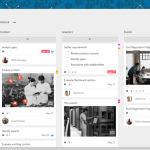As a long-time practitioner of Collaborative Project Management, it sometimes seems that “Collaboration” has become the most overused term in software today. In the race to real-time synchronous communication, email is often the first casualty. As I will explain below, in many cases, solution vendors simply masquerade their software as collaboration alternatives to email without really understanding the true meaning of collaboration.
Let’s start with a common definition. What is Collaboration? Collaboration is not a modern concept nor is it a software, tool, or process. Collaboration means working together to achieve a common objective. Simple. People often confuse “collaboration” with “information sharing” but it’s not the same thing. You can collaborate using pen and paper, walkie-talkies, or smoke signals as long as you are working towards a common goal.
Part 1: Data shows email is the slowest growing
An inescapable fact in today’s hyper-connected world is the surge in Instant Messages (IM) spurred by the growth in social media consumption. According to the Radicati Group, there are currently 2.2 billion IM accounts and this is expected to grow by an annual rate of 7% over the next four years. By 2020, IM accounts are expected to reach 4.1 billion(it has reached 4.2 billion in 2023).
On the other hand, Radicati estimates that when it comes to business email, the number is likely to grow by only 3% (less than 1% a year) between 2016 and 2020.
The result of these converging trends is an emerging narrative that email is dying and is being replaced by more efficient and collaborative forms of communication.
Part 2: Why does email have a bad name?
Now that we’ve put the definition and usage data behind us, let’s look at why email has been considered the anti-collaboration tool. About three years ago, our good friends at McKinsey published a research report claiming that a whopping 28% of interaction workers’ workweek is spent reading and answering emails.
Although I have always been suspicious of the McKinsey data, there is no doubt that email has limitations.
To make things easy, let’s start with what email does NOT do.
Email is not a Knowledge Management System
Email is not a Knowledge Management System and was not built to be. The inboxes of our employees and co-workers contain valuable information and data that will never be distributed widely. The potential learning of an organization is typically not captured. Email is a closed system that cannot be indexed and searched by colleagues.
Email is not a Document Management System
Few things are less efficient than using email to distribute, manage and track documents within a shared environment. Between version control issues and multiple people on cc that “reply all,” it is often a herculean task to keep track of the different threads and to track down the latest version of a document.
The email was not designed for brainstorming
Have you ever tried replacing a virtual (or physical) whiteboard with an email thread to a large group? Trust me, it does not work. Email is best for sharing information with a (relatively) small group but when it comes to brainstorming, email threads tend to get hijacked by the loudest voices (or most vociferous typists).
Email is not a Project Management Software
In an era of online project management software, it should seem obvious that Project Managers should not use email to assign activities and tasks to their team. Sure, ad-hoc requests via email are acceptable, but Project Management requires discipline that involves risk, dependencies, and deadlines that cannot be tracked and managed via email.
Part 3: Why has everyone joined the anti-email bandwagon?
Email has become the scapegoat for all inefficient and redundant communications. In the past few years, a number of software vendors such as Asana, daPulse, and Trello have staked their claim as Collaboration solutions that cut down on redundant and time-wasting emails.
As I will explain below, in many cases, solution vendors simply masquerade their software as collaboration alternatives to email without really understanding the true meaning of collaboration.
Part 4: How does email fit in Collaboration Project Management?
From the perspective of Collaborative Project Management, an email is a valuable tool when used appropriately. Here are just a few examples of when email is probably the best communication tool to use:
- Major project milestone announcements
- Communication with key stakeholders
- Documentation of critical information for future use
Whereas chat is limited to people that are currently available and on a common platform, email can be sent to anyone with a known email address.
Finally, and perhaps more importantly, before collaboration was a buzzword it simply was the word used to describe how people work together to build new things. Collaboration is about applying common sense principles to project work in order to get the best results for the individual, team, and organization.





